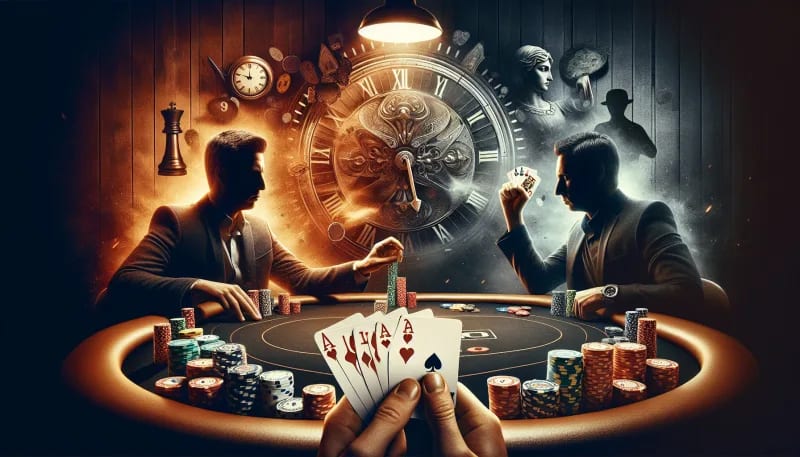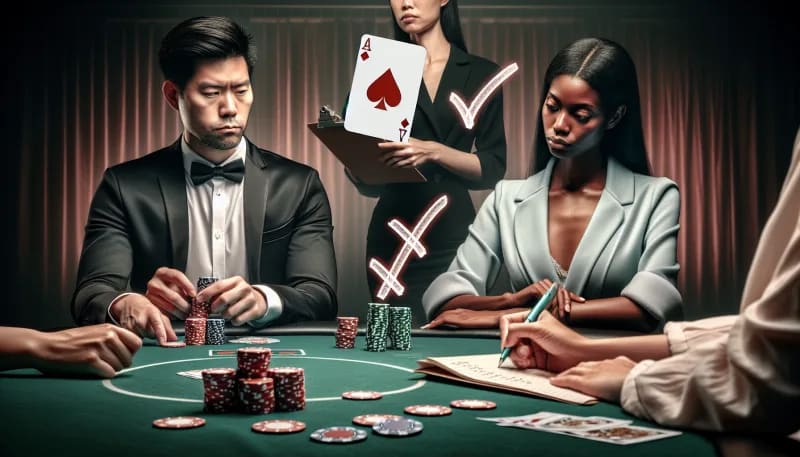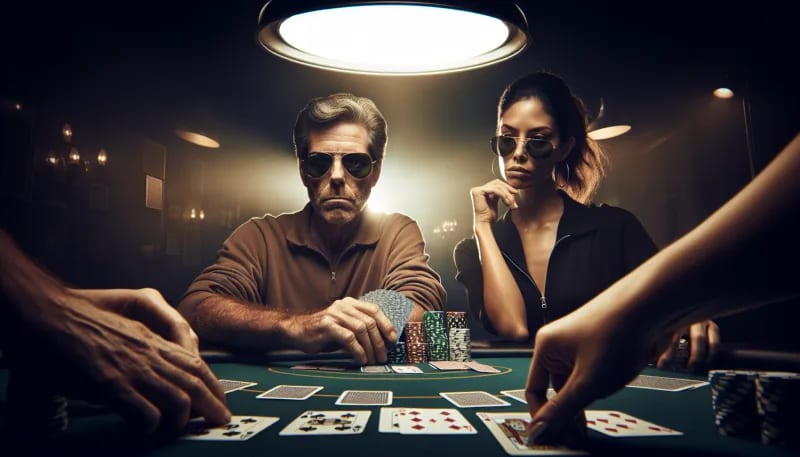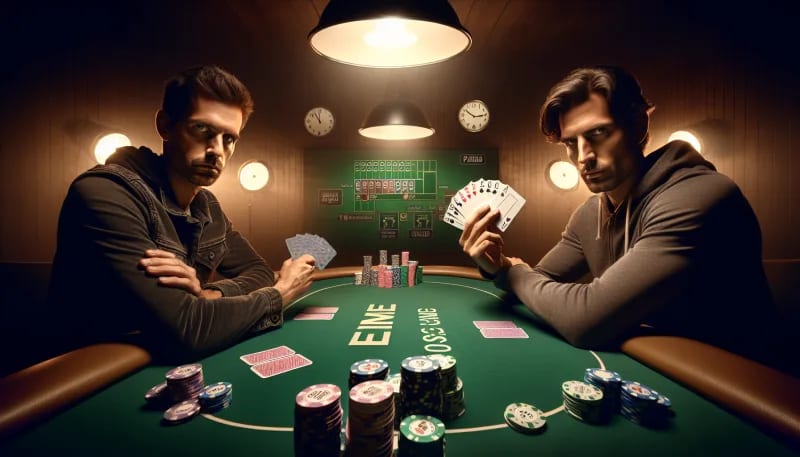Heads Up Poker Strategies: Winning Tactics for Intense Duels
Introduction to Heads Up Poker
Have you ever witnessed the sheer adrenaline rush of a one-on-one poker showdown? That's Heads Up Poker for you. It's the form of poker where it's just you versus one opponent, a true test of poker skill and mental fortitude. Unlike the traditional ring games or tournaments you might be used to, where a table full of players jostle for chips, Heads Up is a different beast entirely.
Why does this variant stand out, you may ask? For starters, the dynamics of the game change entirely when you strip the table down to just two players. Each hand becomes a battle, with aggressive play and psychological warfare stepping into the spotlight. You can't hide in the shadows of a full table; your every move is under scrutiny.
And here's the kicker – as a spectator, the thrill is just as intense. Imagine the tension, watching two gladiators locked in a mental duel, where each card dealt and each chip raised sends ripples through the outcome. Can you feel the excitement yet?
This mano-a-mano setup means that a wider range of hands is in play. Your 2-7 offsuit? Suddenly it's not just a discard; it's a potential weapon. In Heads Up Poker, strategy and skill are magnified. It's not just about the cards; it's about how you play them – and, more importantly, how you play your opponent.
Plainly put, Heads Up Poker is the purest form of the game. It strips down poker to its core, leaving nowhere to hide. Your reads must be sharp, your plays bolder, and your nerves steelier.
What's next, then? Now that you're introduced to the thrilling world of Heads Up Poker, let's dive into the nitty-gritty. Up next, 'Rules and Gameplay', where I'll translate this high-stakes chess game into a language you can understand and start playing. Are you ready to face off against your opponent and see who truly holds the poker prowess?

Rules and Gameplay
Heads Up Poker strips the game down to its purest form: it's just you versus your opponent, no one else to distract you. But don't be fooled, the simplicity in numbers belies a complex and thrilling game. So, how exactly does it work?
Unlike a full-ring game that can accommodate up to 10 players, Heads Up is a mano-a-mano battle. The biggest twist? The dealer button plays a dual role. In a larger game, the button signifies the rotating dealer position. Here, it also marks the small blind. This means the button acts first pre-flop and last post-flop. Got that?
Now, the non-button player posts the big blind, which sets the stakes. They'll have the positional advantage pre-flop, which can set the tone for the hand. Post-flop, this flips, giving the button a potentially critical advantage. It's a dance of power and position, where every move counts. Do you feel the tension building yet?
The structure mostly mirrors larger games but at a rapid pace. There's a pre-flop, flop, turn, and river, each followed by a round of betting. But with shorter stacks relative to blinds, the action is typically more aggressive. There's little time for patience in Heads Up play.
Consider this: in a full-ring game, playing a wide range of hands can spell disaster. Heads Up?** It's a requirement.** The blinds come fast, the hands even faster. You can't afford to wait for pocket aces. Adjusting your range is essential—but more on that in the next section, Essential Strategies.
At its core, Heads Up Poker is all about adaptation. Can you outmaneuver your opponent when you're both in the spotlight? Every hand is a battle, every decision magnified. The ebb and flow of dominance and submission define the game.
Remember, adjusting to the rapid back-and-forth of this format is key. It's less about the cards and more about the clash of wills. So, are you ready to challenge yourself one-on-one? Let's dive into the strategies that can cement your victory.
Essential Strategies
Now that you're familiar with the rules and gameplay, it's time to delve into strategies that can make or break your Heads Up poker game. First off, consider your playing style. Are you the tight player who waits for premium hands, or the aggressive one who applies pressure with a wide range of hands? Heads Up poker demands adaptability – so mix it up. Why be predictable?
In Heads Up play, position is king. You're either on the button or you're not. When you are, it's a golden opportunity. Aggressively exploit this advantage; you act last post-flop. Can you feel the power of position dictating the flow of the game?
Let's talk psychological warfare. Heads Up is as much about playing your opponent as it is about playing the cards. Read their patterns, pick up on their tells. But remember, they're trying to read you too. Throw them off. Intimidation can lead to their mistakes – and your gain.
Lastly, remember balance is key. If you're too tight, your opponent might bulldoze you with aggression. Too loose? They'll wait and trap you with strong hands. Find the sweet spot. Adapt. Observe. Dominate. And keep your emotions in check – can you remain as cool as a cucumber when the heat is on?
After mastering these strategies, you'll want to avoid common pitfalls. My next section, 'Common Mistakes to Avoid,' will guide you through keeping your hard-earned chips secure while climbing to the top. Stay tuned, learn from errors, and keep stacking those chips.
Common Mistakes to Avoid
Transitioning from Essential Strategies, mastering Heads Up Poker is as much about avoiding missteps as it is about playing your best game. Let's talk common pitfalls.
First up: overvaluing hands. In heads-up play, the value of your hands shifts. A pocket pair of eights? Strong in full ring games, but heads up, it's a giant. The trick? Don't get carried away. Have you ever held onto a hand like it's a lifeline, only to drown in the river? It's because heads up, hand values fluctuate rapidly with each street – tread carefully.
Next, consider the opponent you're facing. Are they aggressive? Passive? Failing to adjust to the opponent is like bringing a knife to a gunfight. You need to be a chameleon, constantly changing colors. Play back at aggressors, loosen up against the tight ones. Ask yourself, are you adapting or just going through the motions?
Finally, let's talk chip stack management. You've got to respect your chips like they're the last pieces of chocolate on earth. Go too wild, and you're out in the cold. Too timid, and your stack dwindles to crumbs. Balance is key. Remember, in heads up, every chip is a soldier in your battalion – keep them disciplined and focused.
As we shift towards the Psychology in Heads Up Poker, think about these mistakes: are they just misplays, or are they mental lapses? Each chip lost, each hand misplayed, it's not just a tactical error, but a psychological giveaway. Bold moves are important, but only when they're the right moves. Keep the balance, keep your head clear, and most importantly, learn from every hand you play.
Psychology in Heads Up Poker
Learning from Common Mistakes to Avoid is crucial, but let's delve deeper—into the mental labyrinth of Heads Up play. Ever felt your heart race when it's just you and another at the felt? You're not alone. It's a psychological duel, where the strongest mind often claims victory.
Reading opponents becomes paramount. I always look for tells. Does their hand shake when they bet? Do they avoid eye contact when they're bluffing? These small clues can unfold a story—an edge you can exploit.
Adapting strategies on the fly? That's part art, part science. Heads Up is rapid, and the ability to shift gears is key. If they're playing tight, I loosen up. They're aggressive? I bide my time, waiting to trap. It's a dance, and flexibility is your best move.
Pressure—it's thick enough to cut. Can you keep your cool when every decision counts? Your bankroll, pride, and game are all on the line, one on one, mano-a-mano. This is when champions are forged, when legends are made. How do you deal with this? Simple. Breathe, focus, and remember: it's still just a game.
Believe me, the mental aspect can't be overstated. Ever played mind games? Heads Up poker is full of them. Who can outwit, outplay, outlast? Can you psych out your opponent while keeping your own head straight?
And when it comes to the wire—Mastering the Endgame is next. It's one thing to survive the mental marathon, but can you close the deal when it counts the most? Keep reading. We're about to find out.
Mastering the Endgame
Endgame scenarios in poker tournaments are where legends are made, aren't they? It's a high-pressure cooker, and your strategy must shift dramatically. Chip stack sizes reign supreme in this phase—dictating your moves like a strict coach. I've learned the hard way that you can't play the endgame like the early rounds. It’s a different beast.
You see, when stacks are shallow, the value of stealing blinds increases. This makes picking the right spots crucial. And that's where the magic of push/fold charts enters the fray. These charts become my bible, telling me exactly when to shove and when to step back, based on my stack size and position.
But why embrace the push/fold strategy? Simply because it boils decisions down to two actions, cutting through decision fatigue like a hot knife through butter. With fewer chips to play with, being decisive becomes your best friend. Have you ever been caught in a loop of indecision? Trust me, that's a luxury you can't afford in the endgame.
Let's not forget about the importance of aggression. Short stacks must be aggressive — it's a survival tactic. But the question is, when? That’s where your understanding of your opponents, honed in the heads-up psychological battle, becomes invaluable. Reading their patterns can reveal the perfect moment to strike.
Transitioning from the psychological warfare of heads-up play to the strategic maneuvers of the endgame requires a seamless change in your mental gears. Ready to dig deeper? The next section, 'Practicing Heads Up Poker,' will set you up with drills and exercises to sharpen these very skills. Because, in the end, practice doesn’t just make perfect—it makes champions.
Practicing Heads Up Poker
After delving into Mastering the Endgame, it's clear that the final duel of Heads Up poker is where legends are made. But how do you sharpen your skills in this high-pressure, mano-a-mano showdown? Well, I've found that practice doesn't just make perfect; it makes profit.
First up, hit the online poker tables. Platforms like PokerStars, 888Poker, or Partypoker have dedicated Heads Up games running around the clock. Why not jump in? Start small, of course. Build confidence and competence without risking your shirt.
Remember, there's no better teacher than experience. So, as you play, keep detailed notes. Which hands did you overplay? Which bluffs did you miss? In Heads Up, every hand is a lesson waiting to happen.
Do you ever watch back your own game tapes? Well, you should. Online poker sites often allow you to review past games. Perform a self-analysis. Be critical. Be constructive. Often, it's the little tweaks in your game that can turn a good player into a great one.
And don't forget the wealth of high-level play available at your fingertips. YouTube and Twitch are goldmines for studying Heads Up confrontations. Watch how the pros handle pressure. Pay attention to their bet sizing, their timing, their mind games. And ask yourself, how would you have played those hands?
For a more structured approach, consider Heads Up courses or coaching. Many pros offer their insights for a fee. Yes, it's an investment, but knowledge is a bankroll in itself, right?
Finally, let's talk about mindset. Heads Up is as much about psychological warfare as it is about the cards. Can you stay cool when the heat is on? Can you read your opponent like a blog post?
As we inch closer to Notable Heads Up Poker Matches, remember that knowing the history can teach you patterns that might repeat themselves on your felt battleground. These matches are not just entertaining - they're educational. So, study up. Because who knows, you might just be one Heads Up game away from making your own history.
Notable Heads Up Poker Matches
Have you ever found yourself deep in a poker tournament, the field whittled down to just you and one opponent? That's when the real mind game begins. Heads up poker is not merely about cards; it's about psychology, aggression, and adaptation. Let me take you back to some legendary heads up matches that have left a mark on the poker world.
Remember 2003? The world of poker changed when an accountant from Tennessee, Chris Moneymaker, turned a $39 satellite entry into a $2.5 million first-place prize at the World Series of Poker Main Event. But it wasn't just the money. It was his exhilarating heads up battle with Sam Farha that became an instant classic. Moneymaker's victory over Farha was a catalyst for the poker boom. It showed us that anyone could win with the perfect blend of skill and luck.
Fast forward to 2011. Pius Heinz faced Martin Staszko in another monumental showdown. Their back-and-forth play in the WSOP Main Event was a masterclass in stamina and poise. Heinz ultimately prevailed, but Staszko's display of resilience influenced how I—along with many others—approach endurance in heads-up play.
Then there's the Duel for the Ages, Johnny Chan versus Phil Hellmuth in the 1989 WSOP Main Event. This battle symbolized the passing of the torch as Hellmuth dethroned Chan, ending his chance at a third consecutive title. Think about that. A 24-year-old taking down an established legend. It wasn't just a win; it was a statement—a new era of poker had begun.
These iconic duels weren't just a test of card skills; they forced strategies to evolve. Aggression, hand-reading, and psychological warfare—these matches emphasized them all. Even today, heads up play remains a critical factor in the making of a great poker player. You want a place in poker history? Mastering heads up is essential.
So, as you return to the felt to practice your one-on-one game, remember these moments. Let the legends who shaped the game guide your strategy. And always ask yourself, what would Moneymaker do?







